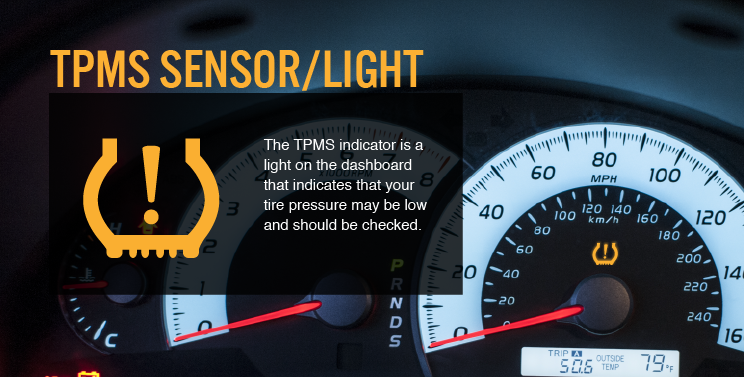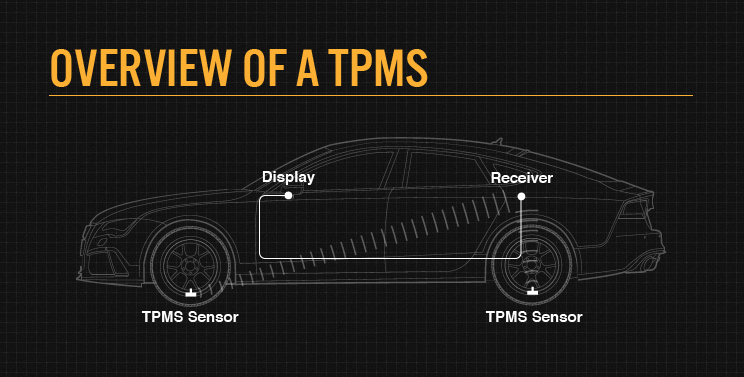TPMS LIGHT ON? WHAT IT MEANS & WHAT YOU NEED TO DO
The purpose of the Tyre Pressure Monitoring System (TPMS) is to alert you when tyre pressure is too low and could to create unsafe driving conditions. If the light is illuminated, it means your tyres could be underinflated, which can lead to undue tyre wear and possible tyre failure. It's important to understand the importance of proper tyre inflation, and how TPMS can help you maintain your tyres.
Maintaining proper tyre inflation is essential to vehicle handling, overall tyre performance, and load carrying capability. A properly inflated tyre will reduce tread movement, reduce rolling resistance, and increase water dispersion. Reduced tread movement gives the tyre a longer tread life. Reduced rolling resistance, the force required to roll a loaded tyre, results in increased fuel efficiency. Increased water dispersion decreases the possibility of hydroplaning.
Both over inflation and under inflation can cause premature tread wear and possible tyre failure. Over inflation can result in decreased traction, premature wear, and the inability to absorb road impact. Overinflated tyres will show premature wear in the centre of the tread. On the other hand, under inflation will cause sluggish tyre response, decreased fuel economy, excessive heat build-up, and tyre overload. An underinflated tyre will show premature wear on both outside shoulders.
The TPMS warning light will help warn you when your tyre pressure is too low. Your TPMS has various illumination patterns that mean different things. Keep reading to find out what they mean.
If you’re learning about tyre pressure sensors for the first time, finding the TPMS indicator on your dashboard is simple. It’s a horseshoe-shaped light with an exclamation point in the centre.

What Does a TPMS Warning Light Mean?
Do you know what to do when the low tyre pressure TPMS symbol illuminates? The first thing to do is manually check your tyre pressures with a gauge and add air until the pressures reach the vehicle manufacturer specification. Keep in mind, your TPMS does not replace routine tyre pressure maintenance. It’s a tool that can help alert you when pressure is low, but a tyre may drop below proper inflation long before the TPMS warning light comes on. The TPMS light comes on when the tyre pressure gets too low or too high.
TPMS Light Illuminates While Driving
When the TPMS light comes on – and stays on – at least one of your tyres is at a low pressure level. Check the pressure of all of the tyres with a gauge and determine the cause of pressure loss and add air or service the tyre(s) as appropriate.
TPMS Light Goes On and Off
When tyre pressure(s) are near the level that triggers an alert, fluctuating temperatures may be causing your TPMS light to turn on and off. This typically occurs when pressure decreases overnight due to a drop in ambient temperature that causes the light to turn on; the light may turn off when pressure increases during the day due to rising ambient temperature and/or heat generated from the driving the vehicle. Use a gauge to check the pressure of all of the tyres and add air to any tyre that is low.
TPMS Light Flashes and Then Stays On
If the light flashes for approximately 60 to 90 seconds every time you start your car and then remains illuminated, this means the TPMS isn’t functioning properly and you should take it to an automotive service centre for an inspection. Until repaired, the TPMS is out of order and is not able to warn you of low tyre pressure. Check the air pressure of all of the tyres with a gauge and add air to the tyres that need it.
Does a TPMS Replace Regular Tyre Pressure Checks?
No! Understanding what a TPMS warning light means and what to do when it illuminates is an important part of a driver’s responsibility. However, TPMS is not a replacement for regular tyre pressure checks. Why? Depending on the situation, the TPMS may have limitations such as:
- The TPMS warning light may be set to illuminate below the tyre pressure needed to carry the load in the vehicle.
- The sensor(s) may not be accurately transmitting tyre pressure data to the on-board computer.
- The system may not be able to accurately determine if a tyre is too low if other tyres are losing pressure at the same rate.

Therefore, even with TPMS, manual tyre pressure checks with a gauge are important to caring for your tyres and vehicle, especially for your safety and that of others. You should check tire pressure once a month, and before a long trip or when carrying extra load.
-
How to Check Tyre Pressure
How to Check Tyre Pressure
Both under inflation and over inflation can cause headaches like premature tread wear and possible tyre failure. The best way to ensure you're getting the most out of your tyres is to check your tyre pressure regularly. We'll show you how.
Click to Learn More -
How to Check Tyre Tread Depth
How to Check Tyre Tread Depth
Heavily worn tread will prevent a tyre from performing as designed and can lead to unsafe driving conditions. One of the simplest, most common ways to check tread depth requires nothing more than a gauge and a few moments of your time.
Click to Learn More